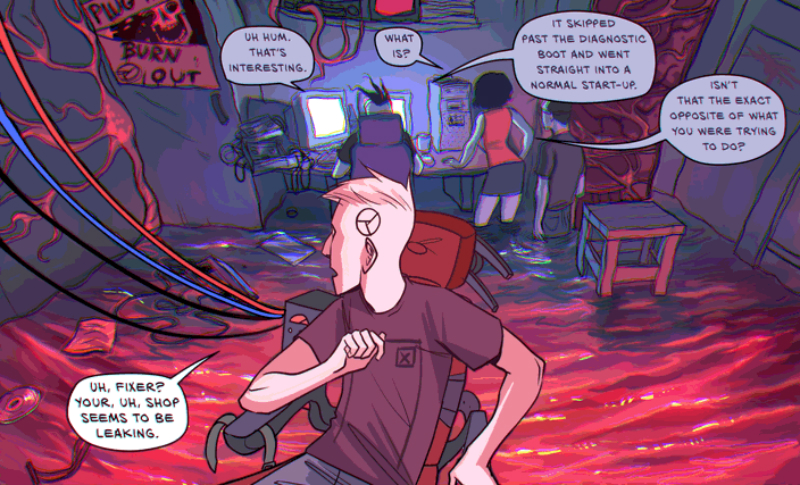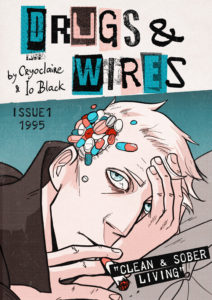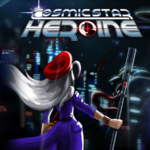
Drugs and Wires
Writers: Cryoclaire & Io Black
Artist: Cryoclaire
A review by Billy Seguire
 The year is 1995. Fifteen years since cybernetics became commonplace, the liberal government of Unylsk is overthrown by an overbearingly conservative ‘Black Soil’ party, turning the once progressive nation into a dangerous place for modified humans to live. Those living the majority of their lives on the net now face a society of distrust and persecution. Taking inspiration from zine culture, dystopian sci-fi, and Windows 95 in the story of washed up VR-junkie Dan, Drugs and Wires is the counterculture narrative we need right now.
The year is 1995. Fifteen years since cybernetics became commonplace, the liberal government of Unylsk is overthrown by an overbearingly conservative ‘Black Soil’ party, turning the once progressive nation into a dangerous place for modified humans to live. Those living the majority of their lives on the net now face a society of distrust and persecution. Taking inspiration from zine culture, dystopian sci-fi, and Windows 95 in the story of washed up VR-junkie Dan, Drugs and Wires is the counterculture narrative we need right now.
On a personal level, Dan’s journey throughout Drugs and Wires is one of withdrawal. The victim of a cybernetic implant has been infected by a virus that prevents him from returning to the world of online VR, cutting off his connection to everything he’s known. His use of recreational opiates to recover from the loss is casual and unapologetic, giving Drugs and Wires a protagonist who finds himself at the very bottom of a well, constantly desperate for his next high and unable to return to the one thing that seemed to give him genuine satisfaction.
The story continuously feels like it’s taking place in the aftermath of better times. Characters are burned out and moving on. As Shitparade says, “anybody worth a damn in the scene either had their brains turned to omlette or ran off with their dicks between their legs,” and that disenfranchisement is key to the tone of the story Cryoclaire and Io Black are trying to tell. As we meet more and more characters who knew Dan in his old life, we learn he’s notorious for his bad trips. It’s a label he doesn’t necessarily identify with and seems outright disgusted to discover how he’s actually been viewed by his peers. There’s regret in his character that leads to total desperation. It’s the sort of arc that cries out for an optimistic ending, as a character with nothing to lose has everything to gain, but nothing in the story so far has pointed that way for Dan yet, proving we’re likely only at the beginning of a longer tale for Cryoclaire and Io Black to tell.
In addition to the personal narrative, Cryoclaire and Black also take care to flesh out the world surrounding Dan and his life. Marilyn Hope-Fokker, the cutthroat executive weaving her way through the b-plot of this narrative, reminds me a lot of Jane Curtain. Her ruthlessness and over-the-top villainy are a great source of black comedy in Drugs and Wires and feels like the sort of element that would be included in a ‘90s dystopia like Tank Girl or The Fifth Element. Like those films, there are enough jokes and black comedy moments in the comic to keep it light and entertaining, particularly any scene involving Lin and her “medical” services.
Stepping back from the main narrative, the global viewpoint of Drugs and Wires nicely makes it stand out from the endless array of cyberpunk dystopias. I’ve read the American version of this story time and time again, but Unylsk is presented with a freshness that allows for new opportunities for exploration and creation. It’s the same reason I enjoy Mad Max for its alternate Australian outback. Cryoclaire and Io Black’s depiction of a world torn apart by social and political upheaval gives legitimate cause to Dan’s dissociation and fear of the real world.
The aesthetic of Drugs and Wires owes a lot to zine culture and the time period of the 1990s. The frequent blend of hand drawn and digital elements put you immediately into that mindset. Characters such as Dan or Lin are designed with punk culture in mind, with jackets, dyed hair, or piercings that seem to eagerly confront and compliment their drab, Eastern European whiteness. Dan’s vacant, drug addled eyes are mournful, and the angular form of his character design becomes all the more prominent in digital sequences. The design visually supports the story at every turn.
The colouring is absolutely nailed, giving a tone to the comic of drab, poor living and malaise, but popping with colour just often enough to avoid becoming totally washed out. Linework reflects the punk narrative well, eschewing complete continuity of shape to highlight the distinct chaos of a fringe community put on edge. Taking advantage of the digital medium, you get to experience flickering screens and low-res gifs that give life to the technology in a way that would otherwise be impossible on the page. There are even interstitial prose chapters dubbed Wirepedia that not only seem like Drugs and Wires own in-universe zine, but mark out the narrative of this alt-history with masterful clarity. It’s both an effective way of giving context to the world without muddying the comic itself with unnecessary exposition.
The Verdict
Check It Out. This is the kind of work that screams independence and subversion. The setup hits close to home in today’s political climate, and the story is genuinely enjoyable to read. I played ROM: Read Only Memories earlier this month, and if that was the utopian ideal of a technology obsessed world, than Drugs and Wires is the grungy dystopia underneath. I love the story that’s coming from this heart of darkness, and the unintentional allegories are truly chilling.
Drugs and Wires is also being released in physical issues, the first two of which can be purchased directly from Cryoclaire’s online store. If you want to support an ongoing story that shows a lot of promise to make it through the long haul, Drugs and Wires seems like the right choice right now.



